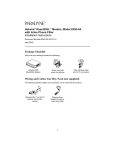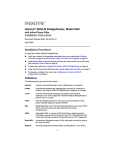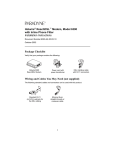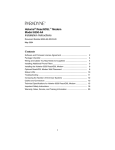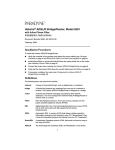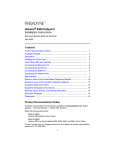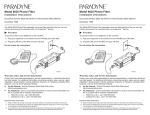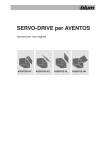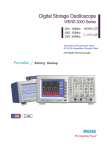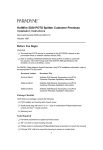Download Paradyne Fax Machine Model 6039 MVL User's Manual
Transcript
Hotwire Model 6039 MVL Phone Filter Installation Instructions Hotwire Model 6039 MVL Phone Filter Installation Instructions Document Number 6039-A2-GN10-00 Document Number 6039-A2-GN10-00 August 1999 August 1999 The Hotwire Model 6039 MVL Phone Filter separates voice and data signals to improve data transmission throughput and minimize audible background noise. A phone is used to represent equipment that plugs into a phone jack and uses the POTS phone line, such as a phone or fax machine. The Hotwire Model 6039 MVL Phone Filter separates voice and data signals to improve data transmission throughput and minimize audible background noise. A phone is used to represent equipment that plugs into a phone jack and uses the POTS phone line, such as a phone or fax machine. Procedure Procedure To connect a phone filter: To connect a phone filter: 1. Unplug your phone from the wall jack. 1. Unplug your phone from the wall jack. 2. Plug the fixed cable (LINE end of the filter) into the wall jack. 2. Plug the fixed cable (LINE end of the filter) into the wall jack. 3. Plug the telephone cable into the PHONE end of the filter. 3. Plug the telephone cable into the PHONE end of the filter. E M ad r lte Fi ne ho br se iquè In C c. hi 11 na 98 na Bel / Fa Fu P TM hi CT geprufte Sicherheit E SERVIC PRODU R L. A T. C E. CE E E10 Q SS U A 02 IPM RY 96 E N T LR 92 99 7 R LR 92 99 7 L. A T. C E. CE E E10 Q SS U A 02 IPM RY 96 E N T TUY M PRODU 2-00 -339 0802 C P/N geprufte Sicherheit E SERVIC e e CT in TUY ad ne ho na Bel / Fa Fu hi in C P br se iquè In C c. hi 11 na 98 Fi lte r LIN TM E 2-00 -339 0802 LIN P/N H P E N O E N O H P 4-Inch Fixed Cable 99-16504 4-Inch Fixed Cable 99-16504 Warranty, Sales, Service, and Training Information Warranty, Sales, Service, and Training Information Contact your service provider directly for any help needed. For additional information concerning warranty, sales, service, repair, installation, documentation, training, distributor locations, or Paradyne worldwide office locations, use one of the following methods: Contact your service provider directly for any help needed. For additional information concerning warranty, sales, service, repair, installation, documentation, training, distributor locations, or Paradyne worldwide office locations, use one of the following methods: Internet: Visit the Paradyne World Wide Web site at www.paradyne.com. (Be sure to register your warranty at www.paradyne.com/warranty.) Internet: Visit the Paradyne World Wide Web site at www.paradyne.com. (Be sure to register your warranty at www.paradyne.com/warranty.) Telephone: Call our automated system to receive current information via fax or to speak with a company representative. Telephone: Call our automated system to receive current information via fax or to speak with a company representative. — Within the U.S.A., call 1-800-870-2221 — Outside the U.S.A., call 1-727-530-2340 ! Important Safety Instructions 1. Read and follow all warning notices and instructions marked on the product or included in the manual. 2. This product is intended to be connected to Listed/Certified telephone wiring with a minimum of 24 AWG (.5 mm) behind a Listed/Certified primary protector. 3. Do not attempt to service this product yourself, as opening or removing covers may expose you to dangerous high-voltage points or other risks. Refer all servicing to qualified service personnel. — Within the U.S.A., call 1-800-870-2221 — Outside the U.S.A., call 1-727-530-2340 ! Important Safety Instructions 1. Read and follow all warning notices and instructions marked on the product or included in the manual. 2. This product is intended to be connected to Listed/Certified telephone wiring with a minimum of 24 AWG (.5 mm) behind a Listed/Certified primary protector. 3. Do not attempt to service this product yourself, as opening or removing covers may expose you to dangerous high-voltage points or other risks. Refer all servicing to qualified service personnel. 4. When installed in the final configuration, the product must comply with the applicable Safety Standards and regulatory requirements of the country in which it is installed. If necessary, consult with the appropriate regulatory agencies and inspection authorities to ensure compliance. 5. In addition, since the equipment is to be used with telecommunications circuits, take the following precautions: — Never install telephone wiring during a lightning storm. — Never install telephone jacks in wet locations unless the jack is specifically designed for wet locations. — Never touch uninsulated telephone wires or terminals unless the telephone line has been disconnected at the network interface. — Use caution when installing or modifying telephone lines. — Avoid using a telephone (other than a cordless type) during an electrical storm. There may be a remote risk of electric shock from lightning. — Do not use the telephone to report a gas leak in the vicinity of the leak. 4. When installed in the final configuration, the product must comply with the applicable Safety Standards and regulatory requirements of the country in which it is installed. If necessary, consult with the appropriate regulatory agencies and inspection authorities to ensure compliance. 5. In addition, since the equipment is to be used with telecommunications circuits, take the following precautions: — Never install telephone wiring during a lightning storm. — Never install telephone jacks in wet locations unless the jack is specifically designed for wet locations. — Never touch uninsulated telephone wires or terminals unless the telephone line has been disconnected at the network interface. — Use caution when installing or modifying telephone lines. — Avoid using a telephone (other than a cordless type) during an electrical storm. There may be a remote risk of electric shock from lightning. — Do not use the telephone to report a gas leak in the vicinity of the leak. Notice to Users of the United States Telephone Network Notice to Users of the United States Telephone Network This equipment complies with Part 68 of the FCC rules. On the bottom of the equipment’s enclosure is a label that contains, among other information, the FCC registration number and ringer equivalence number (REN) for this equipment. If requested, this information must be provided to the telephone company. This equipment is designed to be connected to the telephone network or premises wiring using compatible RJ11C modular plugs and jacks which are Part 68 compliant. The REN is used to determine the quantity of devices which may be connected to the telephone line. Excessive RENs on the telephone line may result in the devices not ringing in response to an incoming call. In most, but not all areas, the sum of RENs should not exceed five (5.0). To be certain of the number of devices that may be connected to a line, as determined by the total RENs, contact the local telephone company. If the Phone Filter causes harm to the telephone network, the telephone company will notify you in advance that temporary discontinuance of service may be required. But if advance notice is not practical, the telephone company will notify the customer as soon as possible. Also, you will be advised of your right to file a complaint with the FCC if you believe it is necessary. The telephone company may make changes in its facilities, equipment, operations or procedures that could affect the operation of the equipment. If this happens, the telephone company will provide advance notice in order for you to make necessary modifications to maintain uninterrupted service. If trouble is experienced with the Telephone Line Filter, for repair or warranty information, please refer to Warranty, Sales, and Service Information. No repairs may be performed by the end user. The equipment can not be used on public coin phone service provided by the telephone company. Connection to party line service is subject to state tariffs. Contact the state public utility commission, public service commission or corporation commission for information. This equipment complies with Part 68 of the FCC rules. On the bottom of the equipment’s enclosure is a label that contains, among other information, the FCC registration number and ringer equivalence number (REN) for this equipment. If requested, this information must be provided to the telephone company. This equipment is designed to be connected to the telephone network or premises wiring using compatible RJ11C modular plugs and jacks which are Part 68 compliant. The REN is used to determine the quantity of devices which may be connected to the telephone line. Excessive RENs on the telephone line may result in the devices not ringing in response to an incoming call. In most, but not all areas, the sum of RENs should not exceed five (5.0). To be certain of the number of devices that may be connected to a line, as determined by the total RENs, contact the local telephone company. If the Phone Filter causes harm to the telephone network, the telephone company will notify you in advance that temporary discontinuance of service may be required. But if advance notice is not practical, the telephone company will notify the customer as soon as possible. Also, you will be advised of your right to file a complaint with the FCC if you believe it is necessary. The telephone company may make changes in its facilities, equipment, operations or procedures that could affect the operation of the equipment. If this happens, the telephone company will provide advance notice in order for you to make necessary modifications to maintain uninterrupted service. If trouble is experienced with the Telephone Line Filter, for repair or warranty information, please refer to Warranty, Sales, and Service Information. No repairs may be performed by the end user. The equipment can not be used on public coin phone service provided by the telephone company. Connection to party line service is subject to state tariffs. Contact the state public utility commission, public service commission or corporation commission for information. Notice to Users of the Canadian Telephone Network Notice to Users of the Canadian Telephone Network The Industry Canada label identifies certified equipment. This certification means that the equipment meets telecommunications network protective, operational and safety requirements as prescribed in the appropriate Terminal Equipment Technical Requirements document(s). The Department does not guarantee the equipment will operate to the user’s satisfaction. Before installing this equipment, users should ensure that it is permissible to be connected to the facilities of the local telecommunications company. The equipment must also be installed using an acceptable method of connection. The customer should be aware that compliance with the above conditions may not prevent degradation of service in some situations. Repairs to certified equipment should be coordinated by a representative designated by the supplier. Any repairs or alterations made by the user to this equipment, or equipment malfunctions, may give the telecommunications company cause to request to disconnect the equipment. Users should ensure for their own protection that the electrical ground connections of the power utility, telephone lines and internal metallic water pipe system, if present, are connected together. This precaution may be particularly important in rural areas. The Industry Canada label identifies certified equipment. This certification means that the equipment meets telecommunications network protective, operational and safety requirements as prescribed in the appropriate Terminal Equipment Technical Requirements document(s). The Department does not guarantee the equipment will operate to the user’s satisfaction. Before installing this equipment, users should ensure that it is permissible to be connected to the facilities of the local telecommunications company. The equipment must also be installed using an acceptable method of connection. The customer should be aware that compliance with the above conditions may not prevent degradation of service in some situations. Repairs to certified equipment should be coordinated by a representative designated by the supplier. Any repairs or alterations made by the user to this equipment, or equipment malfunctions, may give the telecommunications company cause to request to disconnect the equipment. Users should ensure for their own protection that the electrical ground connections of the power utility, telephone lines and internal metallic water pipe system, if present, are connected together. This precaution may be particularly important in rural areas. CAUTION: Users should not attempt to make such connections themselves, but should contact the appropriate electric inspection authority, or electrician, as appropriate. The Ringer Equivalence Number (REN) assigned to each terminal device provides an indication of the maximum number of terminals allowed to be connected to a telephone interface. The termination on an interface may consist of any combination of devices subject only to the requirement that the sum of the Ringer Equivalence Numbers of all the devices does not exceed 5. If your equipment is in need of repair, refer to Warranty, Sales, Service, and Training Information. Copyright 1999 Paradyne Corporation CAUTION: Users should not attempt to make such connections themselves, but should contact the appropriate electric inspection authority, or electrician, as appropriate. The Ringer Equivalence Number (REN) assigned to each terminal device provides an indication of the maximum number of terminals allowed to be connected to a telephone interface. The termination on an interface may consist of any combination of devices subject only to the requirement that the sum of the Ringer Equivalence Numbers of all the devices does not exceed 5. If your equipment is in need of repair, refer to Warranty, Sales, Service, and Training Information. Copyright 1999 Paradyne Corporation


